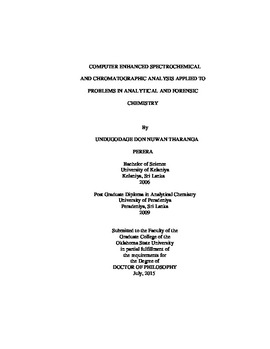| dc.contributor.advisor | Lavine, Barry K. | |
| dc.contributor.author | Perera, Undugodage Don Nuwan Tharanga | |
| dc.date.accessioned | 2016-09-29T18:42:14Z | |
| dc.date.available | 2016-09-29T18:42:14Z | |
| dc.date.issued | 2015-07 | |
| dc.identifier.uri | https://hdl.handle.net/11244/45297 | |
| dc.description.abstract | The main objectives of the research described in this dissertation are: (1) to develop powerful separation methods for the analysis of complex mixtures by systematically adjusting parameters related to selectivity, (2) to better understand polymer swelling as a transduction mechanism for chemical sensing, and (3) to address the issue of distortions in attenuated total reflection (ATR) spectra when compared to transmission spectra of the same samples. Using medium chain length alcohols as mobile phase modifiers in reversed phase liquid chromatography to improve selectivity through enhanced stationary phase solvation, better resolution is achieved in the separation of vanillin and its isomers with water rich mobile phases. This can be attributed to butanol partitioning into the bonded alkyl phase, increasing the contact surface area of the stationary phase and thereby increasing the selectivity of the separation. Copolymers of N-isopropylacrylamide and alkyl acrylic acids are shown to swell reversibly in both low and high ionic strength buffer solutions at ambient and physiological temperatures. The pKa of these particles can be tuned to respond sharply in the physiological pH range (5.0 to 7.4) by varying the degree of cross-linking, the amount of N-tertbutylacrylamide in the formulation or the alkyl chain length of the pH sensitive co-monomer. The ATR correction algorithm to convert transmission spectra from the PDQ library into ATR spectra is shown to address distortion issues such as the relative intensities and broadening of the bands, and introduction of wavelength shifts at lower frequencies, which prevent library searching of ATR spectra using archived IR transmission data. To assess the efficacy of the ATR correction algorithm, search prefilters were successfully developed from simulated ATR spectra for the purpose of identifying the assembly plant of a vehicle from an ATR spectrum of its clear coat. Clear coats whose ATR spectra were obtained using a Nicolet iS50 FTIR spectrometer were correctly classified on the basis of the vehicle's assembly plant using these search prefilters. For some of these validation set samples, there were marked differences between the experimental ATR spectrum and the computed ATR spectrum derived from the corresponding transmission spectrum of the same sample obtained from the Paint Data Query forensic database which can be attributed to weathering. By exposing a fresh surface of the clear coat automotive paint layer to the ATR probe, interference due to weathering was obviated which will facilitate library matching of these samples. | |
| dc.format | application/pdf | |
| dc.language | en_US | |
| dc.rights | Copyright is held by the author who has granted the Oklahoma State University Library the non-exclusive right to share this material in its institutional repository. Contact Digital Library Services at lib-dls@okstate.edu or 405-744-9161 for the permission policy on the use, reproduction or distribution of this material. | |
| dc.title | Computer enhanced spectrochemical and chromatographic analysis applied to problems in analytical and forensic chemistry | |
| dc.contributor.committeeMember | El Rassi, Ziad | |
| dc.contributor.committeeMember | Materer, Nicholas | |
| dc.contributor.committeeMember | Krishnan, Sadagopan | |
| dc.contributor.committeeMember | Kalkan, A. Kaan | |
| osu.filename | Perera_okstate_0664D_14207.pdf | |
| osu.accesstype | Open Access | |
| dc.type.genre | Dissertation | |
| dc.type.material | Text | |
| thesis.degree.discipline | Chemistry | |
| thesis.degree.grantor | Oklahoma State University | |
